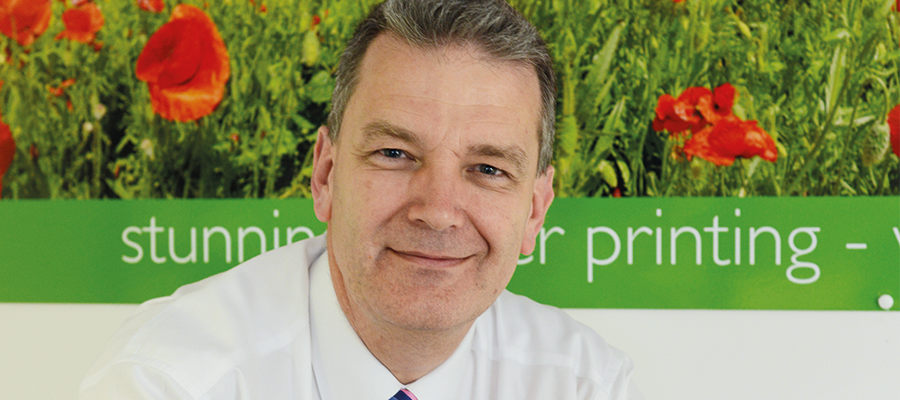Stewart Green entered the print industry in 2003 with the purchase of Kall Kwik Bury St Edmunds.
Ink on paper is no longer enough.
So, now that you are running two successful businesses in our industry, what was your journey into the print industry?
I bought an existing Kall Kwik in September 2003, and it had been trading in Bury St Edmunds for around 20 years, and that was my initiation into our wonderful sector. My background is as far from print as you can get as I started out in the agricultural sector. But my roles were always marketing orientated.
I actually had a look at buying a Kall Kwik franchise in my early 20s, but I just did not have the means to do it. And as I was developing and growing within my agricultural career there also was not the need. But I had a burning desire to run and own my own business, so having spent 22 years working for other people, I took the plunge and went back to Kall Kwik to start my new journey.
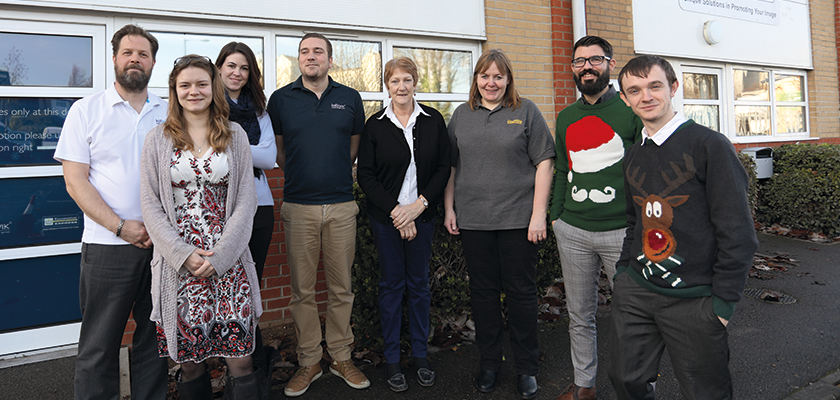
Then with that business running successfully, I decided to spread my wings further and I bought a Recognition Express franchise. The idea just made complete sense, as the Recognition Express product range fits perfectly alongside the graphic design and print services we provide to our customers at Kall Kwik. It meant we could offer a complete package to companies and organisations looking to promote their brand and was a natural addition to our business.
What were the key challenges you faced as you became a new business owner?
One of the reasons I bought a Kall Kwik was that I was not from a print background, and so this was the first mountain to climb. Buying a franchise, I was able to dramatically reduce the learning curve, as I received a tremendous amount of hands-on support, training, and resources to help me.
Another important challenge was the initial restriction on space, as we started off in a retail premises. We outgrew it very quickly and moved to a business unit that was three times the size in 2012, which was split into office, production, and warehouse space. And that was part of the trigger for a lot of growth in terms of attracting new customers and expanding our offering.
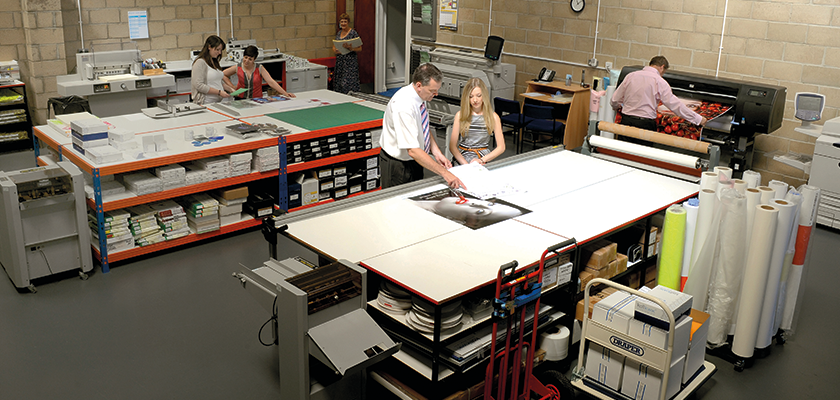
As previously explained, the next step in our progression, and the next challenge was how we could diversify the business to ensure its long-term future. This was the motivation for purchasing a Recognition Express franchise.
In the early years the majority of our income was based on print and very little design and marketing. But all the way through I have always maintained that it pays to have very good designers, as if your design and marketing concept is good, then you will always get the print off the back of it. On top of that, with both Kall Kwik and Recognition Express under our belt, we can do the marketing, design, web design and management, as well as print all under one umbrella. We manage it for the client and deliver it as a properly joined up package.
“If your design and marketing concept is good, then you will always get the print off the back of it”
Today we have managed those challenges and there is continual year-on-year growth with an amazing group of talented individuals that span print production, web design, copy writing, and graphic design. If you get that element of the business right then you win a lot of, if not all, the print from the clients using us for these other services.
So, with that in mind, what is your specific approach to running a business that is a print-service-provider?
We do not sell business cards, brochures, letterheads, and leaflets as our ‘products’. What we sell is a solution to a customer’s problem, and very often printed marketing is part of that overall solution.
“What we sell is a solution to a customer’s problem, and very often printed marketing is part of that overall solution”
The problem is of course they need more customers, or they need their current customers to buy more from them, or a specific new product. So, an example is that we design a sales brochure for them and then map that design onto the business’ website. We also create e-mail marketing campaigns for them, so there is a uniformity for the company’s brand and message.
(Above & below) Whether it is print production, web or print design, or promotional print products, Kall Kwik Bury St Edmunds and Recognition Express Suffolk cover it all
Then we can build into that package the printing and distribution of the brochure through our Kall Kwik resources. That is a physical product, but we do not set out to sell that physical product. It comes as the consequence of selling ourselves as the conduit through which our customers can grow their businesses.
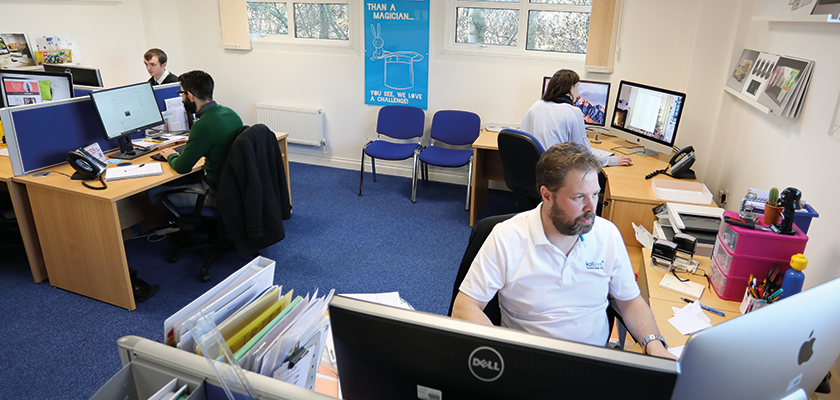
A good example of what I mean is Blockbuster. It was once the king of the video rental market, with an enormous global empire. But it vanished almost overnight in the face of online video streaming. They forgot their product was not a movie in a box with some upsold popcorn. Their product was a relaxed night on the sofa enjoying some entertainment. They confused the physical method of delivery of a product with the product itself. If they had taken all their model online when the likes of Netflix started up then they would still be titans of the industry.
The truth is that a printer’s ‘product’ has never been ink on paper. Their product has always been allowing their customers to communicate information to a defined group of people in a relatively cost-effective way. In the 1970s it was only one of four ways to communicate. You could put your information out on the radio and TV, but if it was for marketing purposes it meant an expensive advert for a brief time frame. Or, you could have it put on a billboard for slightly less money and a slightly longer time frame. Or, you could produce printed marketing for significantly less, that could stay with the target audience significantly longer than the alternatives. This meant that such was the domination of print as a method of delivery for the masses, that it became synonymous with the product itself.
But since the early 1990s there has obviously been an explosion of cheap digitally-based product delivery methods that have completely displaced print’s place as the best method of delivery.
Had we just tried to produce business cards quicker and cheaper than the next guy we would no longer be in business
What we have done is to ensure that we can offer our customers all the major delivery methods that are possible, and remind them that print remains a highly-effective one when used in the right way. Had we just tried to produce business cards quicker and cheaper than the next guy we would no longer be in business.
Looking to the future now, where is there further growth to be found?
I have been lucky enough to experience growth every year I have been in business, and the next steps will be looking to further develop our wide-format print offering, and expanding our marketing services portfolio. We already act as the defacto marketing manager for several of our clients.
There are a good number of both web designers and printers in our area, but there are very few businesses across the region that can offer the breadth we do under one roof, and be an expert in each field.
The growth is to be found in finding customers that value that proposition. If someone is shopping around to find the cheapest price for 10,000 leaflets then we will obviously try and win their business, but that is not the sort of target client we would look to focus on. It goes back again to the product, we want to find customers that need help with the message. It does not matter how cheap those leaflets are, if the message on them is wrong then they are worthless.
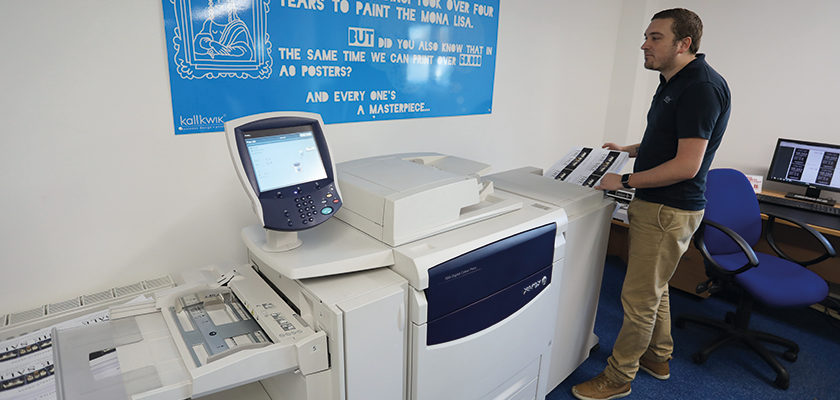
We often get customers ringing us for those leaflets, and then we ask them how they will get it to their customer base? What is their end goal for the leaflets? Suggesting it perhaps would be better to do a smaller but much more personalised direct mail shot. Could we offer them a different design approach to make them more effective? We have achieved year-on-year growth by proactively going out to generate business, not just waiting for it to come to us.
I am very positive about 2018, there is growth back on the agenda for print as part of the delivery method for our product. Indeed, it is by virtue of being one segment of a stronger whole, that its overall volumes will continue to rise.
Looking specifically at your print production arm of the business, what has been your approach to make it as efficient and cost-effective as possible?
We produce our digital work in-house. We decided early on to develop strong relationships with a select number of different trade suppliers for our litho print where longer runs and a premium on quality was required. In addition, if you want really high quality short runs then we have a similar select group of Indigo-enabled trade printers. Our customers really never specify what method of printing they want, they simply want a product at a specific level of price and quality and let us decide what the best method is. We have worked on our relationship with these suppliers, as we understand them better, and they likewise will be more willing to help us in times of need as a long-term customer.
How does that approach work in a sector where a customer can order cheap business cards online from one site, produce a website from an online template, and do e-mail marketing with freely downloadable software?
The issue is with hassle and quality. A customer of course can try and separately stitch all the pieces of their marketing strategy and delivery together. But it takes a long time, and will end up with a poorer result’unless they are a professional marketeer themselves. We take away the pain and hassle, and, with their direction, handle the creation and delivery of their message across all the different delivery methods that exist. By offering services businesses struggle with themselves, then you build a much stronger relationship with them long-term.
Key Company Stats
- Total full time staff 11
- Kall Kwik (BSE) won BAPC Company of the Year in 2012
- Recognition Express (Suffolk) was bought in 2013
- Kall Kwik (BSE) was bought in 2003
Article Source: printmonthly.co.uk

